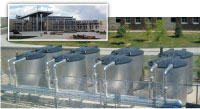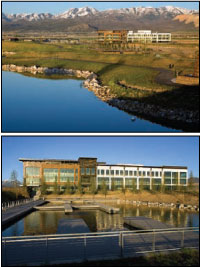view all Case Studies
School Uses Thermal Energy Storage to Slash Energy Costs

Fossil Ridge High School of the Poudre School District in Fort Collins, Colo., boasts a high-performance design. Compared to an existing, similarly sized 1,800-student school in the same district, Fossil Ridge requires about half of the electric demand. Whereas typical school designs use 3 watts/sq. ft., Fossil Ridge uses 1.6 watts/sq. ft.
March 4, 2009 -
Educational Facilities
Fossil Ridge High School of the Poudre School District in Fort Collins, Colo., boasts a high-performance design. Compared to an existing, similarly sized 1,800-student school in the same district, Fossil Ridge requires about half of the electric demand. Whereas typical school designs use 3 watts/sq. ft., Fossil Ridge uses 1.6 watts/sq. ft.
Numerous energy-efficient tactics were put into play at Fossil Ridge. These include daylighting throughout the facility, automated building system controls for all lighting and HVAC equipment, and a thermal energy storage system.
Most school designs in the Poudre County School District call for one ton of cooling for every 1,000 square feet of conditioned space. At Fossil Ridge, the integrated design calls for one ton of mechanical cooling for every 2,000 square feet. The 250-ton cooling load is met with eight Calmac IceBank Energy Storage tanks and a 130-ton chiller.
Inexpensive nighttime electricity is used to make ice inside the ice storage tanks, which then provides cooling to the school the following day, reducing demand charges and expensive peak electricity use.
The thermal energy storage system also helps Fossil Ridge use renewable energy from the photovoltaic panels without penalty. When cloud cover reduces the photovoltaic panel output, ice storage can pick up the slack to minimize electric demand and on-peak purchases.
Next
Read next on FacilitiesNet











